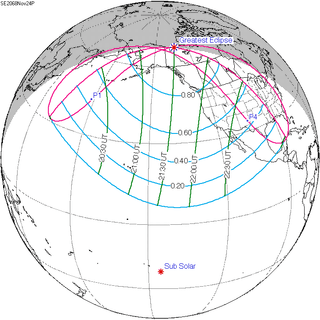Solar eclipse of July 1, 2057
| Solar eclipse of July 1, 2057 | |
|---|---|
 Map | |
| Type of eclipse | |
| Nature | Annular |
| Gamma | 0.7455 |
| Magnitude | 0.9464 |
| Maximum eclipse | |
| Duration | 263 sec (4 m 23 s) |
| Coordinates | 71°30′N 176°12′W / 71.5°N 176.2°W |
| Max. width of band | 298 km (185 mi) |
| Times (UTC) | |
| Greatest eclipse | 23:40:15 |
| References | |
| Saros | 147 (25 of 80) |
| Catalog # (SE5000) | 9635 |
An annular solar eclipse will occur on July 1, 2057. A solar eclipse occurs when the Moon passes between Earth and the Sun, thereby totally or partly obscuring the image of the Sun for a viewer on Earth. An annular solar eclipse occurs when the Moon's apparent diameter is smaller than the Sun's, blocking most of the Sun's light and causing the Sun to look like an annulus (ring). An annular eclipse appears as a partial eclipse over a region of the Earth thousands of kilometres wide.
Related eclipses
Solar eclipses 2054-2058
Each member in a semester series of solar eclipses repeats approximately every 177 days and 4 hours (a semester) at alternating nodes of the Moon's orbit.
| 117 | August 3, 2054 Partial |
122 | January 27, 2055 Partial |
| 127 | July 24, 2055 Total |
132 | January 16, 2056 Annular |
| 137 | July 12, 2056 Annular |
142 | January 5, 2057 Total |
| 147 | July 1, 2057 Annular |
152 | December 26, 2057 Total |
| 157 | June 21, 2058 Partial |
Metonic series
The metonic series repeats eclipses every 19 years (6939.69 days), lasting about 5 cycles. Eclipses occur in nearly the same calendar date. In addition the octon subseries repeats 1/5 of that or every 3.8 years (1387.94 days).
| 21 eclipse events, progressing from north to south between July 1, 2000 and July 1, 2076 | ||||
|---|---|---|---|---|
| July 1-2 | April 19-20 | February 5-7 | November 24-25 | September 12-13 |
| 117 | 119 | 121 | 123 | 125 |
 July 1, 2000 |
 April 19, 2004 |
 February 7, 2008 |
 November 25, 2011 |
 September 13, 2015 |
| 127 | 129 | 131 | 133 | 135 |
 July 2, 2019 |
 April 20, 2023 |
 February 6, 2027 |
 November 25, 2030 |
 September 12, 2034 |
| 137 | 139 | 141 | 143 | 145 |
 July 2, 2038 |
 April 20, 2042 |
 February 5, 2046 |
 November 25, 2049 |
 September 12, 2053 |
| 147 | 149 | 151 | 153 | 155 |
 July 1, 2057 |
 April 20, 2061 |
 February 5, 2065 |
 November 24, 2068 |
 September 12, 2072 |
| 157 | ||||
 July 1, 2076 | ||||
References
External links
| Wikimedia Commons has media related to Solar eclipse of 2057 July 1. |
